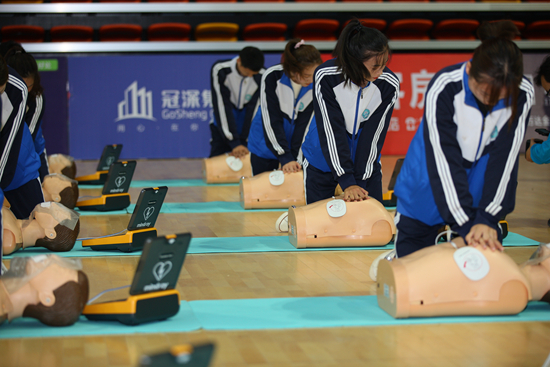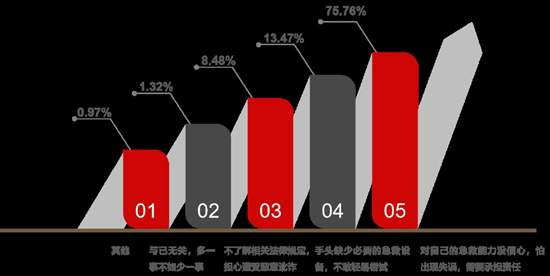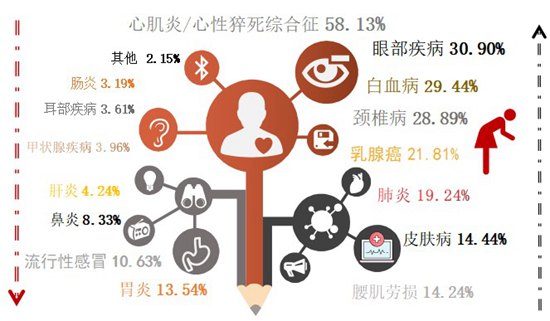Nearly 60% of the college students surveyed are worried about "sudden death", and mastering this knowledge may save lives.

Young students learn CPR operation. Zheng Chen/photo

The reason distribution of college students’ anxiety when taking first aid measures (%). Photo courtesy of Lian Si Research Group

Distribution of diseases that college students are most worried about (%). Photo courtesy of Lian Si Research Group
From the sudden death of a young actor when recording a program, to the sudden death of a college student on the court, and then to the sudden cardiac arrest of Zhang Jingjing, a nurse who helped Hubei Province in Shandong Province, who died after being rescued … The sudden death of young people is frequent, which makes the "sudden cardiac death" attract social attention. September 12th this year is the 21st "World First Aid Day". Recently, the report "Investigation on College Students’ Public First Aid Cognition and Use of Emergency Equipment" led by Lian Si, a professor and doctoral supervisor of university of international business and economics National Institute of Opening to the Outside World, was published. The report shows that young students have a strong awareness of the risk of sudden death, and they have a strong desire to learn and grow up in the knowledge of cardiopulmonary resuscitation (CPR) and the use of automated external defibrillator (AED). However, the awareness rate of relevant knowledge and skills is low, and the ability of emergency rescue is obviously insufficient.
Lian Si told the reporter of China Youth Daily and China Youth Network: "As far as the whole society is concerned, young people, especially those born after 1990s with high academic qualifications, often have high self-demands and expectations. However, while Excellence has become a habit, it has also become a problem that cannot be ignored. "
Because most sudden cardiac deaths occur outside medical institutions, such as families and public places, most of the first witnesses are not medical professionals. Therefore, mastering more first-aid skills may be able to successfully save lives and reduce the degree of injury at the scene.
Over 90% of the respondents hope to learn the knowledge of cardiopulmonary resuscitation, and less than 5% can fully master it.
The Investigation Report on College Students’ Public First Aid Cognition and Campus AED Popularization (hereinafter referred to as the Report) written by Lian Si’s research group shows that 58.13% of the college students surveyed are most worried about myocarditis/sudden cardiac death syndrome, which is much higher than other diseases. Among all the first-aid knowledge categories, 61.46% of the college students surveyed said they wanted to know the knowledge of cardiopulmonary resuscitation most. 92.57% of the respondents thought it was "very necessary" and "relatively necessary" for the school to organize students to systematically learn the knowledge about cardiopulmonary resuscitation, but only 4.86% could fully master the knowledge about cardiopulmonary resuscitation.
"Based on this situation, it is very necessary to strengthen young people’s understanding of first aid knowledge and improve their ability to control related equipment." Lian Si said that promoting first aid knowledge and AED operation skills among young people can effectively reduce the mortality rate of sudden cardiac death, significantly improve the success rate of rescue of critical and severe heart diseases, and minimize the threat of sudden death to life; On the other hand, young people have a strong sense of social responsibility. They have learned first aid knowledge and AED operation skills, which can promote the formation of a good public first aid atmosphere in the society, guide the public to actively share first aid knowledge and skills, and finally form a social atmosphere in which all the people will know first aid and dare to save.
Bad living habits increase the probability of sudden death of young people, and the survival rate of those who are successfully rescued within "golden 4 minutes" can reach 32%
"Traditionally, people think that sudden death is a geriatric disease and has little to do with young people. However, in recent years, data show that young people are also high-risk people. " Hu Zhicheng, a member of the research group and attending physician of the Department of Cardiology, Fuwai Hospital, China Academy of Medical Sciences, said that the main cause of sudden cardiac death among young people is organic heart disease. Electrolyte or acidolysis imbalance, stress or mood fluctuation also significantly increase the probability of sudden cardiac death in patients with organic heart disease. In extreme cases, severe electrolyte or acidolysis imbalance, stress or emotional fluctuation itself can also lead to sudden cardiac death. Many congenital or hereditary diseases are more common among young people.
"In addition, young people often stay up late, and the proportion of unhealthy living habits such as smoking and drinking is high. In addition, the fast pace of life and the pressure of work and study make the electrolyte or acidolysis balance disorder, stress or mood fluctuation frequent." Hu Zhicheng said.
"Cardiac arrest is the main cause of sudden cardiac death." Hu Zhicheng introduced that the rescue time of cardiac arrest is extremely short, and the success rate of rescue is directly related to the start of rescue time. In the event of cardiac arrest, timely and effective cardiopulmonary resuscitation is very important. The survival rate of patients successfully rescued in "golden 4 minutes" can reach 32%, and the survival rate of patients will decrease by 7%-10% for every 1 minute delay in rescue time. Only by giving effective first aid to patients in the "golden 4 minutes" can the mortality rate of patients with cardiac arrest be significantly reduced.
"If a person with cardiac arrest is found outside a medical institution or in a place without defibrillation equipment, he should immediately call for help and quickly start cardiopulmonary resuscitation by hand; If you are in a medical institution or a place with defibrillation equipment, you should quickly obtain a defibrillator to check the patient’s heart rhythm. If you meet the defibrillation indications, you should immediately defibrillation, and strive to get the most effective treatment in the shortest time and improve the patient’s survival rate. " Hu Zhicheng said.
Hu Zhicheng said that the "instantaneous death" of sudden death did not have a clear warning signal before it happened. Even if there were so-called warning signals, most of them were not typical. However, if you have chest tightness, chest pain, breathlessness, palpitation, toothache, jaw pain and discomfort, left shoulder, left upper limb, back pain, or blackness, transient disturbance of consciousness, aura of syncope and other symptoms related to activities recently, you need to see a doctor in time to make sure your heart state.
Create an atmosphere of "can save, can save and dare to save", so that everyone can become the guardian of life.
China Cardiovascular Disease Report 2018 released by the National Cardiovascular Center estimates that there are 544,000 cases of sudden cardiac death in China every year, with an average of 1,490 people suffering from sudden cardiac death every day. However, in the huge sudden cardiac death, the success rate of out-of-hospital rescue is less than 1%.
The report of Lian Si’s research group shows that the lack of first aid knowledge is one of the reasons why college students are unwilling to participate in on-site first aid. When encountering an unconscious person who has stopped breathing, 68.33% of the respondents choose to "dial 120 and wait in the same place", and only 25.76% can "go to check immediately and take first aid measures".
"In this society with increasing uncertainties, any artificially controllable risk factor is the object of our efforts to reduce. Medical first aid requires not only the courage to stand up, but also certain first aid skills and experience. In the face of AED,’ not using’ and’ not dare to use’ will affect the efficiency of use. " Lian Si said.
The survey found that college students’ willingness to use AED to help the wounded will be improved if they have fully mastered the use of AED, and 90.28% of the respondents said that they are willing to use AED when they have fully mastered the operation knowledge of AED.
The report further shows that even if they know the knowledge about cardiopulmonary resuscitation and AED, college students still have some concerns when helping others in an emergency. The main reason is that they have no confidence in their first aid ability, and they are afraid of making mistakes and need to take responsibility. The research group believes that in addition to the inadequate training and publicity of relevant first aid knowledge, the lack of students’ first aid ability, the imperfect legal system related to on-site first aid and the unclear division of responsible subjects are also important factors leading to the above concerns.
Lian Si said that in order for AED to play an effective role, all groups in society should work together and make joint efforts to contribute to the domestic first aid cause. He suggested that the publicity and education of first aid knowledge should be strengthened; Constantly innovate and expand diversified and diversified forms of education and training; Establish and improve laws and regulations related to first aid at the national level, and encourage the public to be courageous; Actively promote the deployment of AED equipment, accelerate the popularization of the concept of first aid and catalyze the willingness of young people to rescue. "Universities and education departments should act as good propagandists and enlighteners; Medical departments at all levels, the Red Cross and other relevant departments act as good feedback and guardians; Government agencies and judicial organs play the role of good guarantors and legislators, and promote the improvement of contemporary youth groups in national security and first aid health literacy. "
"Only when the whole society has the awareness, atmosphere and skills of first aid, the public will not only" save "and" dare to save "but also" be willing to save "when encountering unexpected situations, thus truly building a good social fashion of" everyone for me, I for everyone "and" everyone learns first aid and first aid is for everyone ",so that everyone can become a guardian of life." Lian Si said.